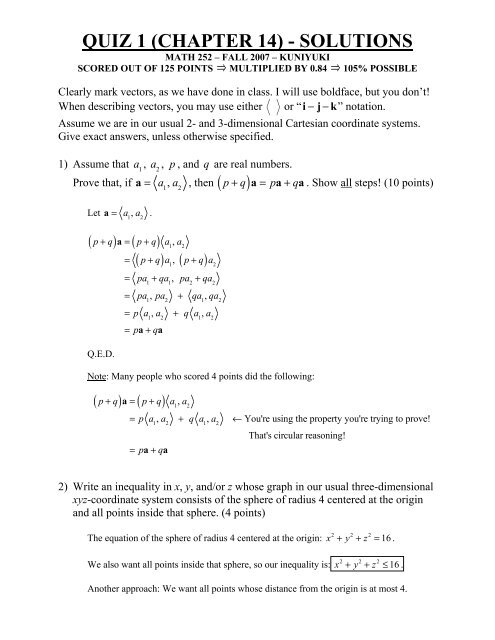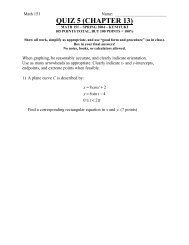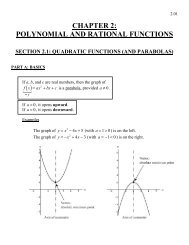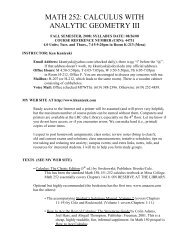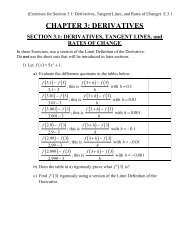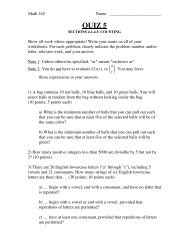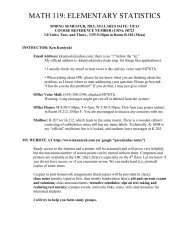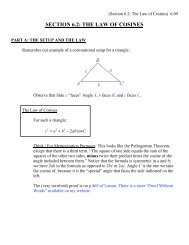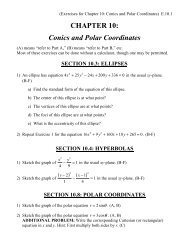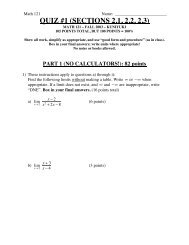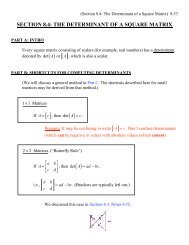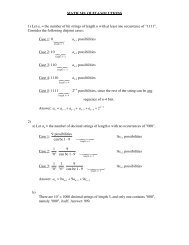QUIZ 1 (CHAPTER 14) - SOLUTIONS - Math Notes and Math Tests
QUIZ 1 (CHAPTER 14) - SOLUTIONS - Math Notes and Math Tests
QUIZ 1 (CHAPTER 14) - SOLUTIONS - Math Notes and Math Tests
Create successful ePaper yourself
Turn your PDF publications into a flip-book with our unique Google optimized e-Paper software.
3) Find all real values of c such that the vectors ci + 10j + ck <strong>and</strong> ci − 2j − k areorthogonal. (8 points)The vectors are orthogonal ⇔ Their dot product is 0.( ci + 10j + ck) • ( ci − 2j − k) = c,10, c • c, − 2, −1= c 2 − 20 − c= c 2 − c − 20Find the real zeros:c 2 − c − 20 = 0( c + 4) ( c − 5) = 0c = − 4 or c = 54) Assume that a <strong>and</strong> b are vectors in V n , where n is some natural number.Using entirely mathematical notation (i.e., don’t use words) …(8 points; 4 points each)a) Write the Cauchy-Schwarz Inequality.a • b ≤ abb) Write the Triangle Inequality.a + b ≤ a + b5) Let a, b, <strong>and</strong> c be vectors in V 3. (4 points total; 2 points each)a) ( a • b)c is … (Box in one:)a scalar a vector neither, or undefineda • b is a scalar, <strong>and</strong> a scalar times a vector is a vector.Think: Scalar multiplication.b) a × ( b × c) is … (Box in one:)a scalar a vector neither, or undefinedIn fact, this is a Triple Vector Product. b × c is a vector, <strong>and</strong> a crossed with it is avector.
6) Assume that a, b, <strong>and</strong> c are three nonzero vectors in V 3such that a × b = a × c .Which of the following must be true? Box in one: (3 points)i) The vector a <strong>and</strong> the vector b − c are parallel.ii)The vector a <strong>and</strong> the vector b − c are perpendicular (or orthogonal).iii) b = c .a × b = a × c ⇔a × b − a × c = 0a × b − c⇔( ) = 0 ⇔a || ( b − c)7) The line l passes through the points P − 7, 2, 0(10 points total)a) Find parametric equations for l.First, find a direction vector for l : PQ = 4 − ( −7 ), −1− 2, 5 − 0= 11, −3, 5( ) <strong>and</strong> Q 4, −1, 5( ).Use this direction vector together with one of the given points (say P) to obtainparametric equations for l :⎧ x = −7 + 11t⎪⎨ y = 2 − 3t , t in R⎪⎩ z = 5tb) Find symmetric equations for l.Solve the three equations in a) for t <strong>and</strong> equate the resulting expressions for t.x + 711 = y − 2−3 = z 5
8) Consider the following two lines:l 1:⎧x = 3 + t⎪⎨y = 1 − 2t⎪⎩ z = −5 + 3t<strong>and</strong> l 2:⎧x = − 2 − 3u⎪⎨y = 3 + 4u⎪⎩ z = 8 − 2u( t, u ∈R)(35 points total)a) Find the point of intersection between the two lines.Equate the expressions for corresponding coordinates, <strong>and</strong> solve the system:⎧ 3+ t = − 2 − 3u⎪⎨ 1− 2t = 3+ 4u⎪⎩−5 + 3t = 8 − 2u⇔⎧ t + 3u = −5⎪⎨− 2t − 4u = 2⎪⎩⎪3t + 2u = 13( Eq.1)( Eq.2)( Eq.3)Solve the subsystem with, say, the first two equations:⎧⎪ t + 3u = −5⎨⎩⎪ − 2t − 4u = 2( Eq.1)( Eq.2)The unique solution is: ( t = 7, u = − 4) .Verify that ( t = 7, u = − 4) satisfies Eq.3:( ) ⇒3t + 2u = 13, t = 7, u = − 43( 7) + 2( − 4) = 13( )13 = 13 Checks out.Therefore, the two given lines intersect at the point for whicht = 7, u = − 4( ) .
We need a point on the desired plane. Three immediate choices are:( 3,1, −5) , which is on line l 1,( − 2, 3, 8), which is on line l 2, <strong>and</strong>( 10, −13,16), which is the intersection point we found in part a).Let’s use n = 8, 7, 2 as our normal <strong>and</strong> ( 3,1, −5) , say, as our point.St<strong>and</strong>ard form for an equation of the plane:( ) = 08( x − 3) + 7( y − 1) + 2 z − ( −5)General form for an equation of the plane:8x + 7 y + 2z − 21 = 09) Consider the point P( 7, 2, −1) <strong>and</strong> the plane 4x − 3y + 2z + 60 = 0.Distance is measured in meters. (16 points total)a) At what point does the given plane intersect the x-axis?(We will call this point Q.)Along the x-axis, y = 0 <strong>and</strong> z = 0 , so we substitute y = 0 <strong>and</strong> z = 0 in the givenequation <strong>and</strong> solve for x:4x − 3y + 2z + 60 = 0, y = 0, z = 0 ⇒4x − 3 0( ) + 2( 0) + 60 = 0The desired point is: Q( −15, 0, 0) .4x + 60 = 0x = −15b) Find a normal vector for the given plane. (We will call this vector n.)n = 4, −3, 2 .
c) If we let the vector p = QP , then the distance between the given point P<strong>and</strong> the given plane equals: comp np . Use the component formula tofind comp np . Round it off to the nearest tenth of a meter.Find the p vector:p = QP= 7 − ( −15), 2 − 0, −1− 0= 22, 2, −1The desired distance is:comp np = p • n==n22, 2, −1 • 4, −3, 24, −3, 288 − 6 − 2( 4) 2 + ( −3) 2 + ( 2) 2= 80 29≈<strong>14</strong>.9 metersObserve that we would have gotten the same answer from the shortcut formulagiven in Section <strong>14</strong>.5 for a point x 0, y 0, z 0 ( ) <strong>and</strong> a plane ax + by + cz + d = 0 :h = ax 0 + by 0 + cz 0 + da 2 + b 2 + c 2= 4 7( ) − 3( 2) + 2( −1) + 60( 4) 2 + ( −3) 2 + ( 2) 2= 80 29≈ <strong>14</strong>.9 meters
10) Matching. (12 points total)Fill in each blank below with one of the following:A. An EllipsoidB. A Hyperboloid of One SheetC. A Hyperboloid of Two SheetsD. A ConeE. An Elliptic ParaboloidF. A Hyperbolic ParaboloidI. The graph of 1 2 x2 − 3y 2 − z 2 = 5 is __C__.(Think: x 2 − y 2 − z 2 = 1.)II. The graph of x 2 + 7 y 2 − z = 0 is __E__.(Think: x 2 + y 2 − z = 0 , or z = x 2 + y 2 .)III. The graph of 4x 2 − 9y 2 + z 2 = 0 is __D__.(Think: x 2 − y 2 + z 2 = 0 , or y 2 = x 2 + z 2 .)IV. The graph of 4x 2 − y 2 + 11z 2 = 7 is __B__.(Think: x 2 − y 2 + z 2 = 1.)
11) Consider the graph of 4x 2 − y 2 + 11z 2 = 7. This was in Problem 10, part IV.Assume that k takes the place of real constants. (12 points total)The graph is a hyperboloid of one sheet. For simplicity, consider: x 2 − y 2 + z 2 = 1a) The axis of the graph is the … (Box in one:)x-axis y-axis z-axisObserve that y is the “odd man out” in x 2 − y 2 + z 2 = 1.b) The conic traces of the graph in the planes x = k are … (Box in one:)Ellipses Hyperbolas ParabolasLet k be a real number such that k > 1. The trace of the graph ofx 2 − y 2 + z 2 = 1 in the plane x = k is given by:k 2 − y 2 + z 2 = 1, x = kk 2 − 1 = y 2 − z 2 , x = ky 2 − z 2 = k 2 − 1 , x = kWe obtain hyperbolas.> 0c) The conic traces of the graph in the planes y = k are … (Box in one:)Ellipses Hyperbolas ParabolasLet k be a real number. The trace of the graph of x 2 − y 2 + z 2 = 1 in theplane y = k is given by:x 2 − k 2 + z 2 = 1,x 2 + z 2 = 1+ k 2 ,> 0y = ky = kThis is a circle, but we have ellipses for the traces of the graph of theoriginal equation because of the deformations produced by thecoefficients.The ellipse family of traces makes sense, since planes of the form y = kare perpendicular to the axis of the graph of x 2 − y 2 + z 2 = 1, which is ahyperboloid of one sheet.
d) The conic traces of the graph in the planes z = k are … (Box in one:)Ellipses Hyperbolas ParabolasLet k be a real number such that k > 1. The trace of the graph ofx 2 − y 2 + z 2 = 1 in the plane z = k is given by:x 2 − y 2 + k 2 = 1, z = kk 2 − 1 = y 2 − x 2 , z = ky 2 − x 2 = k 2 − 1 , z = kWe obtain hyperbolas.> 012) Find an equation (in x, y, <strong>and</strong> z) of the surface obtained by revolving thegraph of 4y 2 + 25z 2 = 1 (in the yz-plane) about the z-axis. (3 points)Since y is the “non-axis” variable in the equation above, <strong>and</strong> x is the “missingvariable” …We replace y 2 with ( x 2 + y ) 2 . We don’t “touch z.”4( x 2 + y ) 2 + 25z 2 = <strong>14</strong>x 2 + 4y 2 + 25z 2 = 1We are taking an ellipse in the yz-plane, <strong>and</strong> we are using it to generate anellipsoid.


